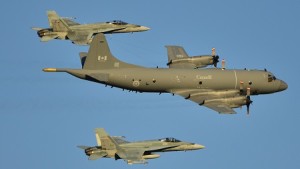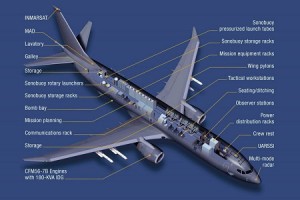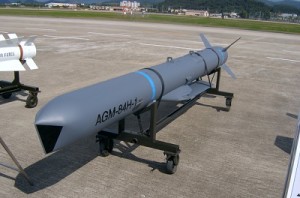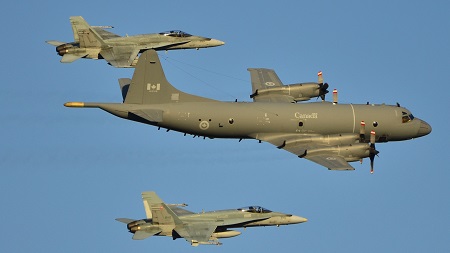Some four years ago, lack of funding blocked the Canadian air force’s proposal to purchase replacements for its fleet of 30-year-old Aurora CP-140 maritime surveillance aircraft.
Instead, a plan was set to upgrade 14 Auroras and have them on the flight line by 2020 and to keep them in the air until replacements are acquired sometime around 2030.
But what about replacing the aging and expensive-to-operate Auroras with a Canadian-built aircraft?

The Bombardier CS300 is expected to get its certification within the next six months. The CS100 is already certified in North America and currently conducting its European proving flights.
The issue Bombardier is having at present is securing funding to keep themselves afloat to this long enough for the C Series to prove itself with its first operator Swiss and secure more orders. Air Canada, United, and other major airlines are awaiting Bombardier’s fate before buying their own C Series aircraft as nobody wants to be stuck with an orphan aircraft.
The Canadian government could use the opportunity to look at contracting Bombardier to build a CS300 variant to replace the Auroras.
Putting aside the $19,750 flight hour cost of the Aurora’s and the fact that they’re ancient and long since out of production, for roughly $6,000 per flight hour, Canada could have a Canadian built military aircraft with big export potential.

The cost savings and efficiency alone make it an appealing choice since many countries looking at the P-8 Poseidon would instead get a lighter aircraft with better range and far less cost with regards to maintenance and acquisition which is the main sticking point for a few potential P-8 clients.
In 2014, it was announced that further upgrades would push the Aurora’s modernization costs to over $2 billion.
The CS300 costs about $71 million per unit. The P-8 Poseidon costs $171.6 million per unit fly-away compared to the $93.3 million cost of the 737-800 it’s based on. The Poseidon also required the 737-900’s wings which no doubt put the cost up further. So the Poseidon costs $78.3 million per unit more than the platform that it’s based off.
So if a CS300 based replacement comes in at $60 million more per airframe that puts the per-unit cost at $131 million per airframe.
The Poseidon program costs $32.7 billion total so assume a $30 billion total for the CS300. 25 examples would cost us $2.6 billion so in total the program would come in at $32.6 billion. I imagine that would likely be somewhat cheaper but the writer would rather overestimate than underestimate as the writer, is not an expert on pricing these things out. Just in case, anyone is wondering, that would come to $1,249 per taxpayer (26.1 million based on 2012 numbers) and Canada would be able to make money on that investment for decades down the road selling export models.
Given that the CS300 has components manufactured in several locations ranging from China, France, Belgium, Belfast, and others and receives final assembly in Mirabel, Quebec, it isn’t out of the realm of possibility to share those costs with other countries seeking new maritime aircraft on tighter operations budgets while creating and sustaining more manufacturing jobs here in Canada in the process.
As far as structural upgrades, the CS300 could have the fuselage modified to utilize a similar internal weapons bay to what the P-8 employs. The CS300 fuselage is just a tick shorter than the 737 based P-8 at 127.0 ft. and only .1 inches smaller in diameter at 12.2 inches.
Given the 737-800 empty weight of 91,300 lbs and the P-8’s 138,296 lbs, the writer will use the extra 46,996 lbs as what the Argus II would be expected to take on. According to Aerospace-Technology.com, the Bombardier CS300 weighs just 38,199 lbs and is comprised of 46 per cent advanced composites, 24 per cent Aluminum-lithium, 21 per cent standard materials, 8 per cent titanium and 1 per cent steel.
Add the 46,996 lbs of equipment from the P-8 and the total weight climbs to 85,195 lbs. That leaves 63,805 lbs for fuel, ordinance and crew.
Not to mention the heavy use of composites reduces structural wear and corrosion which when flying low over the Ocean is an excellent advantage to have.
The CS300 could handle flying low but would also need to be designed with higher-altitude surveillance in mind. The new advanced sonobuoys have a much longer detection range and with the advanced detection systems being utilized these days the extra altitude allows a much larger area to be mapped out.

The CS300 has a slightly smaller wingspan (115.1′ vs 123.6′) which shouldn’t make adding two similar external hardpoints per-wing like the Poseidon too difficult. This would enable the CS300 to carry the AGM-84K standoff land attack missile-expanded range (SLAM-ER). The strong wing design should enable these accommodations with little to no extra effort beyond retrofitting.
The SLAM-ER is a cruise missile designed by Boeing based off of the AGM-84E SLAM which was an evolution of the McDonnell Douglas Harpoon anti-ship missile.
The SLAM-ER has a range of 250 km’s and is designed to be carried by various aircraft, one of which is the Boeing F/A-18 Super Hornet which would bode well for commonality if Canada went for the Super Hornet as a replacement for our legacy Hornets.
The Aurora’s planned upgrades would actually be a perfect fit for the CS300 instead and as Steve Daly, security expert and writer with the Canadian American Strategic Review, outlined, one or two could be kept as avionics test-beds for the program.
At the 2015 Paris air show, Bombardier also announced that the CS300’s range has climbed from 5,463 km (2,950 nm) to 6,112 km (3,300 nm), it’s maximum takeoff weight (MTOW) rise from 139,600 lbs to 149,000 lbs, it’s maximum passenger load rise from 145 to 160 and it’s total payload has risen from 38,200 lbs to 41,250 lbs. Bombardier’s original predictions of a 6,200- foot takeoff run at MTOW also saw a reduction to 5,000 feet. The landing distance has increased by 50 feet to 4,800.
Bombardier has a real game changer in the CS300 and if Canada plays it’s hand right, it can come out with a program that will not only save money over the much older Aurora fleet, it will provide potential offsets in the form of exports. Unlike the over-saturated fighter jet market, the Maritime patrol market is pretty barren by contrast and consists of aircraft that are mainly based on legacy civilian designs. We could provide a cheaper alternative that’s based on a design that will be relevant well beyond 2040.
Most important of all, Canada has the chance to save a Canadian Aerospace manufacturing giant in the process and breathe new life into its dwindling economy and manufacturing sector.
*************


Comments are closed.